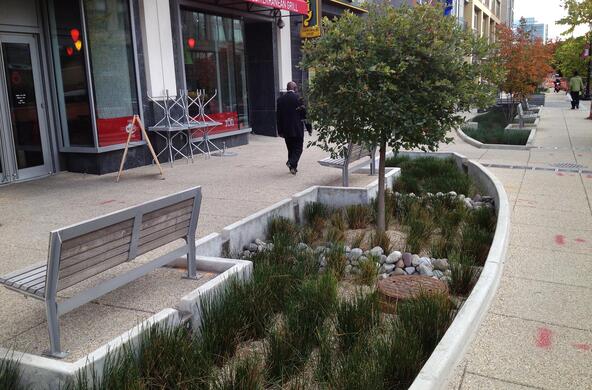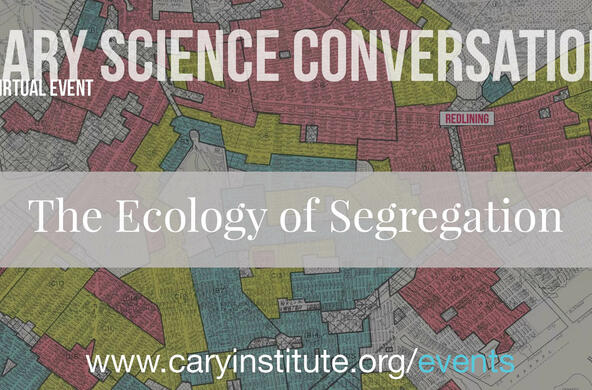Green infrastructure has been embraced as a tool to help cities achieve sustainability and resilience goals while improving the lives of urban residents. How green infrastructure is defined guides the types of projects that cities implement, with enduring impacts to people and the urban environment.
A new nationwide analysis of 122 plans from 20 US cities, published today in Frontiers in Ecology and the Environment, found that many plans fail to explicitly define green infrastructure. When they do, they tend to focus on stormwater management, favoring engineered facilities over parks and larger urban green spaces. The study is the first systematic review of the use and definition of the green infrastructure concept in US city plans.
Lead author Zbigniew Grabowski, who completed the work as a postdoctoral associate at Cary Institute of Ecosystem Studies, explains, “Green infrastructure is broadly understood to be a good thing, but many city plans lack a clear definition of what it actually is. Hydrological definitions dominate. This narrow view can limit project funding and cause cities to miss out on vital social and ecological services that more integrative green infrastructure can provide.”
Green infrastructure has its roots in 19th century landscape design. Its original conceptualization was broad, taking in parks, trail systems, gardens, and other natural landscape features that provide benefits for people and the environment. This shifted in 2007, when the US Environmental Protection Agency defined green infrastructure as a set of best practices for managing stormwater, to meet Clean Water Act regulations.
Coauthor and Cary Institute scientist Steward T.A. Pickett notes, “While the landscape concept of green infrastructure includes stormwater management benefits, stormwater concepts rarely consider the broader landscape. This can mean lost opportunities for more expansive benefits, among them high-quality green spaces, management of diverse environmental risks, and improved urban public health.”

The team’s nationwide analysis explored: the types of city plans that define green infrastructure, how it is defined, and the functions and benefits assigned to green infrastructure projects. Twenty medium to large US cities, representing the major biomes, were included. City plans (303) were collected and screened for references to green infrastructure, with 122 meeting criteria for analysis. These included comprehensive/strategic, sustainability, watershed restoration, and climate plans.
Cities that were part of the assessment: Atlanta, Austin, Baltimore, Chicago, Denver, Detroit, Louisville, Miami, Milwaukee, New Orleans, New York City, Philadelphia, Phoenix, Portland, Sacramento, San Juan, Seattle, St. Louis, Syracuse, and Washington DC.
Among the team’s findings: 39% of plans that refer to green infrastructure do not define what it is. Of those that do, stormwater concepts predominate (59%), followed by landscape concepts (17%), ‘integrative’ – which combine stormwater and landscape concepts (15%), and other (9%). Across plans containing definitions, 57% had several different definitions, with a total of 153 unique definitions identified, indicating that green infrastructure means different things to city planners across the US.

What qualifies as green infrastructure also varied widely. Across GI definitions, 693 different types of green infrastructure were identified. The features most commonly included in plans were trees (90%), rain gardens (75%), ‘other stormwater facilities’ (55%), blue-green corridors (60%), and green roofs (65%). Some cities went so far as to include green energy and alternative transportation technologies within their definitions of GI.
Green infrastructure benefits identified by city plans include water quality, recreation, health, city livability, and property value. Across cities, social benefits were most commonly cited in plans, followed by environmental, economic, ‘built environment’ (to enhance or support existing built structures, like a sewer or transportation system), and ecological benefits. Some cities also identified more specific benefits such as recovery from extreme weather events (e.g. Washington DC), new business opportunities (e.g. Miami), and social revitalization (e.g. Atlanta).

Taking in the breadth of concepts outlined in the 122 plans, the authors developed a synthetic definition of green infrastructure to guide future research and planning, and help cities and researchers adopt a more comprehensive view of what green infrastructure entails and the benefits it confers.
Green infrastructure (GI) refers to a system of interconnected ecosystems, ecological–technological hybrids, and built infrastructures providing contextual social, environmental, and technological functions and benefits. As a planning concept, GI brings attention to how diverse types of urban ecosystems and built infrastructures function in relation to one another to meet socially negotiated goals.
Coauthor Timon McPhearson, a research fellow at Cary Institute and Director of the Urban Systems Lab at The New School, concludes, “The US is poised to make large scale, needed, investments in urban infrastructure. To ensure these investments build environmental resilience in a way that benefits the lives of all urban residents, we’ve put forth a more comprehensive definition of green infrastructure, to guide planning, policy, and practice – with the goal of facilitating more equitable urban greening.”
Across the country, advocacy organizations, communities, planners, researchers, and practitioners are working to transform urban planning to better address equity and justice issues. To support these efforts, the research team created a website to share deeper project findings and recommendations for the 20 cities examined. You can explore the site here: www.giequity.org.
All are invited to learn more about this work at ‘Building Equity into US Urban Green Infrastructure Planning’, an interactive webinar to be held on January 27, 2022 at 1pm ET. The virtual event is free and will include ample time for Q+A.
Citation
Grabowski, Zbigniew J., Timon McPhearson, Marissa Matsler, Peter M. Groffman, and Steward T. A. Pickett. 2022. What Is Green Infrastructure? A Study Of Definitions In Us City Planning. Frontiers In Ecology And The Environment. Wiley. doi:10.1002/fee.2445.
Investigators
Zbigniew Grabowski – The New School, Cary Institute of Ecosystem Studies
Timon McPhearson – The New School, Cary Institute of Ecosystem Studies, Stockholm University
Marissa Matsler – Cary Institute of Ecosystem Studies
Peter Groffman – Cary Institute of Ecosystem Studies and City University of New York
Steward Pickett – Cary Institute of Ecosystem Studies
Acknowledgement
This work was funded by The JPB Foundation through a two-year project entitled: Environment, Health, and Poverty: Is Green Infrastructure a Universal Good?.
Cary Institute of Ecosystem Studies is an independent nonprofit center for environmental research. Since 1983, our scientists have been investigating the complex interactions that govern the natural world and the impacts of climate change on these systems. Our findings lead to more effective management and policy actions and increased environmental literacy. Staff are global experts in the ecology of: cities, disease, forests, and freshwater.





